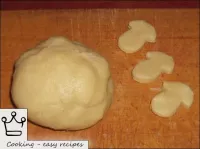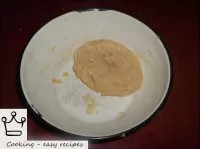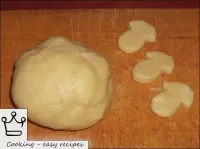Main shortbread dough
 20 min (your 20 min)
20 min (your 20 min)20 min your 20 min
The main recipe of sand dough based on the recipe of sand dough for confectioners. This basic shortbread recipe comes in handy for making cookies, cakes or cake cakes.
Flour - 1.5 cups (200-230 g), Sugar - 0.3 cups (70 g), Butter or margarine - 150 g, Egg - 1 pc., Salt - 1 pinch
The best temperature for shortbread is 15-20 ° C. At a lower temperature, the dough hardens and is difficult to roll. At temperatures above 25 ° C, the oil in the dough softens and can separate from the rest of the products; such dough crumbles during rolling, and the products prepared from it are very tough. If it is heated by hand, it must be cooled before cutting. Thick pieces of dough bake poorly, so sand dough is rolled into a layer 5-10 mm thick. They do it on a flat board, otherwise in the places of thickening it will not be baked, but where it is thinner, it will burn. The baking sheets are not greased, since the sand dough products are not burned. Sand products are baked at 200-230 ° C till golden colour on the surface and inside the cakes. Sand dough layers baked for sliced cakes and cakes are heated up with the tip of a knife. If the layers are baked in one place, and the dough is still raw in another place, then sheets of paper are placed on the baked places above and below and baking continues until the entire layer is baked. If the heat spreads unevenly in the oven, and in one part of the seam the dough is baked, and in the other - raw, you can put sheets of paper on well-baked places and continue baking until the whole seam is ready. If the layer nevertheless sticks to the baking sheet, you can solve the problem in this way: cool the baking sheet, then take it with both hands and, leaning slightly, hit the edge, but not much, against the corner of the table, then try to carefully move the baking sheet from its place.
 Русский
Русский Український
Український Deutsch
Deutsch Español
Español Français
Français Italiano
Italiano Português
Português Қазақ
Қазақ Türkçe
Türkçe 한국인
한국인 日本
日本 简体中文
简体中文 中國人
中國人 عرب
عرب
 Gradually pour flour.
Gradually pour flour.  Dough is kneaded.
Dough is kneaded.  The main shortbread is ready! Before use, it is recommended to cool the dough in the refrigerator.
The main shortbread is ready! Before use, it is recommended to cool the dough in the refrigerator. 